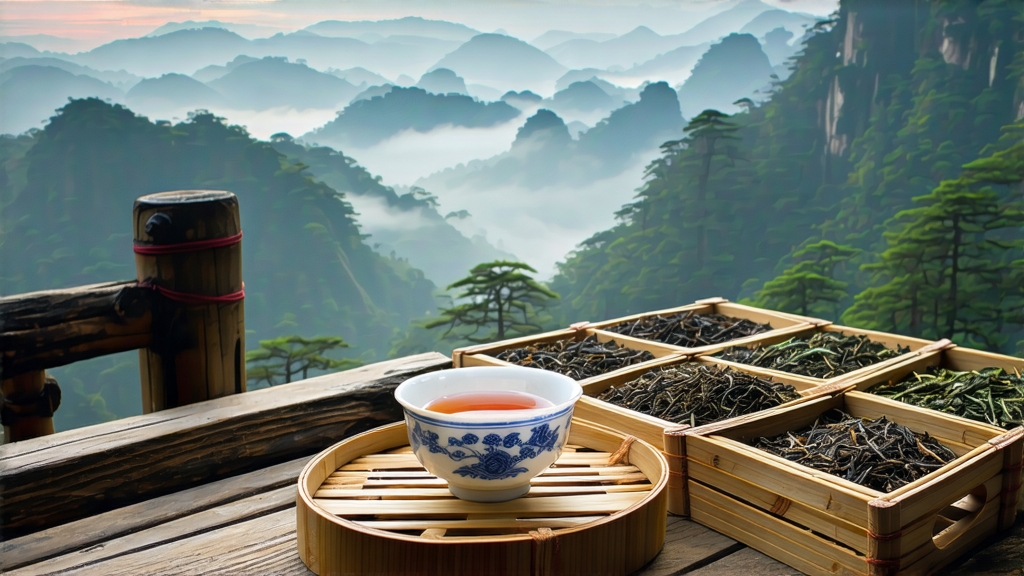
Long before Assam, Ceylon or Keemun entered the lexicon of tea, there was Lapsang Souchong—an audacious, resin-sweet leaf born in the granite gorges of China’s Wuyi Mountains. To many Western palates the name evokes “smoky tea,” yet beneath the fragrant veil of ember lies a lineage that rewrote the history of global tea trade. In 1604 Dutch merchants carried the first chests of this crimson-black leaf from the port of Xiamen to Europe, where it was christened “bohea” and quickly eclipsed the green teas that had previously monopolised the caravans of the Silk Road. Within decades London coffeehouses were advertising “souchon” as the fashionable cure for melancholy, and the British East India Company began plotting plantations in India precisely to break China’s monopoly on what would become known as black tea. Thus every modern cup of breakfast tea can trace its ancestry to the smoke-wreathed hamlets of Tongmu Guan, today a protected enclave inside the Wuyi UNESCO World Heritage site.
Geography is the first secret. The Min River cuts a mist-laden canyon through weathered rhyolitic cliffs, creating a microclimate where humidity hovers at 85 % and temperatures oscillate gently between 12 °C and 20 °C. In these conditions the indigenous small-leaf cultivar—Qizhong or “original bush”—develops short, thick leaves rich in polyphenols and volatile terpenes, the biochemical precursors to both malt sweetness and pine resin affinity. Only leaves picked within a ten-kilometre radius may bear the official designation “Zheng Shan Xiao Zhong,” literally “small sort from the original mountain,” a 2002 Chinese geographical indication that separates authentic Tongmu tea from the caramel-coloured, artificially scented copies flooding supermarket shelves.
The crafting begins at dawn on the third week of April, when two leaves and a bud are plucked between 8 a.m. and 11 a.m., while dew still guards against mechanical bruising. The baskets are rushed to the upper floor of a three-hundred-year-old wooden house where bamboo trays, called qing, are laid over rafters above a dying pine-log fire. Here withering is a dialogue between cool mountain air and fragrant smoke; the leaf loses 60 % of its moisture in four hours, far faster than the twelve-hour wither used for unsmoked black teas. Once the leaves feel parchment-dry to the touch, workers roll them by hand in 3-kilogram batches on rattan mats, twisting cells just enough to release oxidative enzymes without shredding the leaf. Oxidation follows in cedar-lined boxes; the pile is turned every forty minutes so that oxygen can convert catechins into theaflavins, the ruby pigments that give Lapsang Souchong its signature copper liquor and brisk, wine-like briskness. When the aroma shifts from apple-like greenness to dried longan and honey, firing begins. Pinewood is stacked in a sunken hearth; iron pans rest on beams half a metre above the flame. Fresh leaf is tossed for ninety seconds, then quickly transferred to bamboo sieves that are slid into wooden smoke chambers. For the next eight hours the tea absorbs volatiles such as guaiacol and syringol, compounds that bond with leaf sugars to create the tea’s celebrated balance of campfire warmth and caramelised fruit. A final charcoal bake the following morning fixes the flavour and drops moisture to 3 %, ensuring decades of ageing potential.
Purists recognise two stylistic forks. Traditional Song-style Lapsang is smoked heavily, the leaf almost obsidian, the liquor tasting of pine tar, dark chocolate and pipe tobacco—an uncompromising profile once beloved by Russian czars and still favoured in Eastern European markets. In contrast, the newer “unsmoked” or “fruit-style” Xiao Zhong bypasses the pine chambers, relying instead on long withering and gentle charcoal roasting to coax natural lychee and malt notes; it was invented for the contemporary Chinese domestic market that associates smoke with cheap exports. Between these poles lie experimental micro-batches: chestnut-wood smoked versions that lend a nutty creaminess, or lapsang finished in used Islay whisky barrels, marrying peat and pine in a cup that thrills sommeliers from Berlin to Tokyo.
To brew Laps